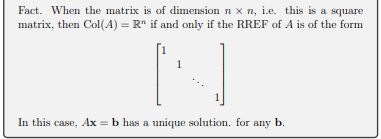Linear Equations, Matrices (Chapter 11, 12, 13, 14)
1/54
There's no tags or description
Looks like no tags are added yet.
Name | Mastery | Learn | Test | Matching | Spaced |
|---|
No study sessions yet.
55 Terms
linear eqn is of the form
a1x1 + a2x2 + . . . + anxn = b
ai and b are real numbers (scalars) and xi are unknowns/variables/indeterminants
linear system
collection of linear eqns
solution to a linear system
solution to ALL eqns of the system simultaneously
general solution
set of all solutions; may be infinite solutions presented w parameters
linear system is consistent when
there exists at LEAST one soln; otherwise the system is inconsistent
linear system is homogenous if
all the CONSTANT TERMS (terms w/o variables) = 0, otherwise the linear system is inhomogenous
types of general solutions
no solution
a unique solution
infinite solutions (could be w parameters)
gaussian elimination
method for solving linear systems systematically
involves elementary row operations
using an AUGMENTED matrix
valid operations on an AUGMENTED MATRIX
add a MULTIPLE of a row to another
exchange two rows in the matrix
multiply a row by a NON-ZERO scalar
homogeneous systems will always
have at least one solution, therefore homo systems are always consistent
~
“now equivalent to”
REF (row echelon form)
all zero rows (if any) are at the BOTTOM
first non-zero entry in each ROW is a 1 (CALLED A LEADING 1 OR A PIVOT)
each leading 1/pivot is to the R of the leading 1s of the rows above
reduced row echelon form
like REF, except the only non-zero entry in each COLUMN is a pivot (each column has one 1 and the rest are 0)
if a row is ever [ 0 0 0 | a ] and a is non-zero,
the system is inconsistent
we say that two linear systems are equivalent if
they have the same general solution.
Two matrices A is row equivalent to B, written A ∼ B if
B can be obtained from A by elementary row operations
Any matrix can be turned into RREF via elementary row operations. Furthermore,
the RREF we get is unique.
steps to reduce linear system to REF
interchange the top row w another if it is needed tro bring a non-zero entry to the first row of the left-most column
scale R1 to get a pivot (the 1 is left most)
Eliminate the rest of the left-most column using the pivot in R1
now ignore the 1st row and repeat steps 1→ 3 w next row until you get REF
steps to reduce linear system to RREF
first do steps to reduce to REF
if the right-most pivot is in R1, stop
start w right-most pivot and use to eliminate every entry above it in its column
go to next column and go back to the first step here
to make parametric forms of general solutions
set the non-pivot columns to parameter variables and put in para form
rank of a matrix A is denoted
rank(A)
rank(A)
number of pivots in any REF of matrix A
the conversion from REF to RREF does not change the number of pivots
if matrix A has rank(A), then an augmented matrix with A is
B = [A|b] w b as a column vec, which has its own rank as rank(B) or rank(A|b)
rank(B) is always ____________ rank(A)
greater than or equal to
if rank(B) > rank(A), the system is
inconsistent
if rank(A) = rank(B), the system is
consistent
2 cases of rank(A) = rank(B)
rank(A) = number of unknowns → system has a unique solution
rank(A) < number of unknowns → system has infinite solutions
rank(A) is always _____________ number of unknowns
less than or equal to
traffic flow network of one-way street
then convert to REF form and make parametric eqns for each variable
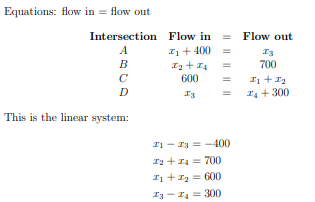
scenarios for traffic network: minimum flow along road
the constant in eqn with the road variable (xi)
scenarios for traffic network: closing a road
set the relevant variable to 0
traffic network constraints
one way streets, therefore xi >= 0
0 <= parameter variable <= smallest constant in system
if the solution after setting a variable to 0 (solve for parameter first and then solve for all the other variables) is all positive, then there are no traffic jams
solving systems w parameters
augmented matrix has coeffs that are variables
to be consistent, they must be values that allow rank(A) to equal rank(A|b)

what are all the vectors that are a linear combination of [insert span of vectors]
start w/ x1(v1) + x2(v2) + x3(v3)
put into augmented matrix [A|b] with b as [a, b, c] (but vertical)
reduce to REF
and det the conditions a, b, c must be so that rank(A) = rank(A|b)
different ways to think of matrices
a table of numbers
the augmented matrix of a linear system
a collection of column vectors
a collection of row vectors
a mathematical object in its own right
a matrix w ‘m’ rows and ‘n’ columns is called an
m by n matrix, with size m x n
matrix notation entry
go down vertical 2, then go right 3

adding matrices and scalar mult
and you have a zero matrix of ANY SIZE
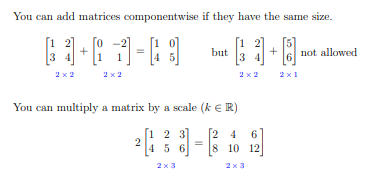
matrix transpose
if A is m x n then A-transpose is n x m and the rows of A are the columns of A-transpose
transpose operation on matrices satisfies

matrix product
matrix A of size m x n and matrix B of size n x p, their product is size m x p
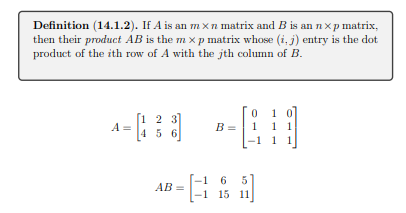
expressing linear system as a matrix eqn
Ax = b where x and b are a column vecs and A is a matrix
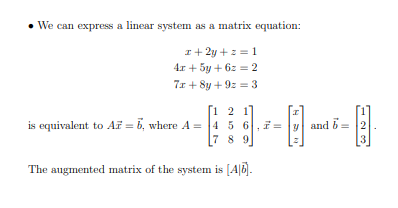
expressing linear combo as a matrix multiplication
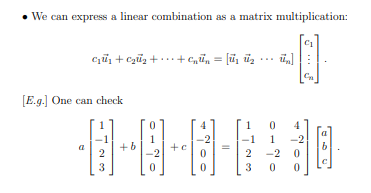
if AB = 0, ________ A or B has to be the zero-matrix
neither
ways matrix mult is diff from num mult
AB ≠ BA (could be true in rare cases)
AB = 0, and neither A or B has to be the zero matrix
if AB = AC, you can’t cancel out A to get B = C
identity matrix
denoted as Ik (k is a subscript) for k x k matrix
has 1’s on diagonal (top left to bottom right)
matrix product of a matrix of size n x k with an identity matrix of size k x k gives back the original matrix itself BECAUSE THE IDENTITY MATRIX IS A MULTIPLICATIVE IDENTITY
properties of matrix product
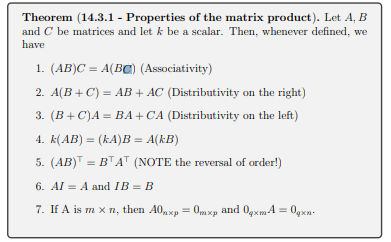
if matrix has size m x m, it is a square matrix. given a square matrix and a pos exponent integer ‘n’:
A^n = A*A*A*A*A … *A (n times)

find the pattern by getting the product of the first few patterns'
recognize if it produces the identity matrix
use exponent rules
expressing linear system w ‘n’ unknowns with matrices
x = [x1, x2, …..] or x = [x, y, z] or x = [a, b, c]
and the variables in x are the variables for each column of the matrix
![<p>x = [x1, x2, …..] or x = [x, y, z] or x = [a, b, c]</p><p>and the variables in x are the variables for each column of the matrix</p><p></p>](https://knowt-user-attachments.s3.amazonaws.com/cdb1672c-b17c-40fe-9ed7-a8c7b4eda2ac.png)
let A be a matrix of size m x n, Col(A) =
subspace in Rm generated by the columns of A
column space of A
Ax = b is consistent if and only if
b is in the span of Col(A)
Col(A) = Rm if and only if
Ax = b is consistent for ALL b belonging to Rm
dim(Col(A)) =
rank(A)
square matrix of size n x n, Col(A) = Rn if and only if
